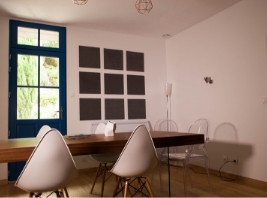We have therefore seen that acoustic treatment should not be confused with sound insulation. Acoustic treatment is concerned with the sound emitted inside a room and concerns elements within your room. Conversely, sound insulation is concerned with stopping the sound coming from outside a room and therefore concerns building materials.
The noise present in your room comes from direct and indirect waves. The latter are the waves that “bounce” off the wall before reaching your ears.
There are 3 main types of products to improve your acoustics. The bass traps that block the low frequencies. The acoustic panels that tackle the mid and high frequencies. The diffusers that mainly allow you to return energy. Depending on your objective and your room, you will choose one or all of these products.
Acoustic panels can be positioned on the walls or ceiling. Very often, treating only part of the walls is sufficient. Depending on the objective, the positioning and the number of panels to be used will be different.
After absorbing certain frequencies, the diffusers try to give “life” to the sound so that the room does not sound totally “dead”. In all cases, they are positioned vertically, i.e. with the eyelets facing upwards.
The shape of the bass trap does not matter and they are positioned in the corners of the room (or behind the speakers), ideally over the entire height of the room, so they should be stacked, as far as possible, up to the ceiling.
Measuring the room is far from essential, unless you’re a professional who wants to achieve a very precise result.
In addition, to optimize your acoustics, choose rooms with different lengths, widths and heights. Also, choose inert materials that do not vibrate and are natural.
Finally, in addition to having good absorption coefficients, our solutions are aesthetic and easily integrated.








